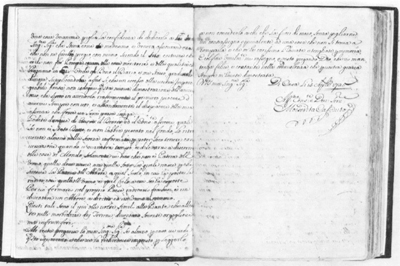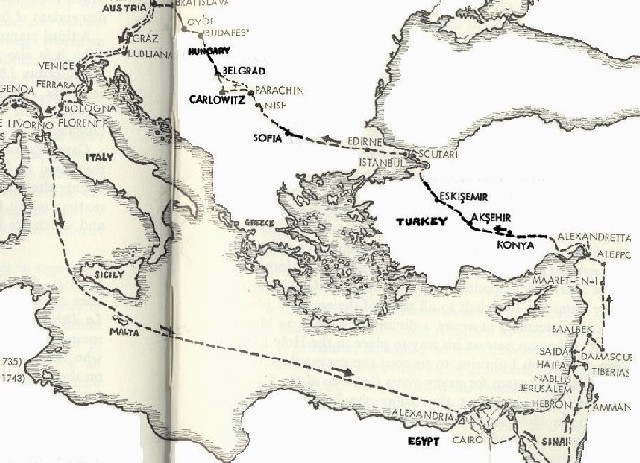|
INTRODUCTION (source: Richard Barnett,
The Travels of Moses Cassuto)
Who
was Moses Vita Cassuto?
Moses Vita Cassuto is a little-known member of the early eighteenth
century of a distinguished Jewish Florentine family of which happily
representatives are still with us.
Posterity should know him as one of the long list of Jewish travellers
whose painstaking records of their often painful journeys did so much
to guide their contemporaries and to enrich our
knowledge in later ages.
Moses
Cassuto in his diary written for his wife discloses incidentally something
of himself.
He was a merchant of reasonable means, a dealer in precious stones but
an educated man of the world, accustomed to mix in the highest society;
he was devoutly religious and devoted to his family, and we see him
as a patient (if not always very precise) recorder of things seen and
heard, and a careful scribe. In visiting places attributed Biblical
or other pious associations, he is frankly credulous and uncritical.
Perhaps be is not to be reckoned in the front rank of either diarists
or travel writers, but in this restricted field he certainly by his
sincerity holds his place and our interest, whether as Jews or historians.

page of the diary
introducing the story of his first journey, signed "Moise Vita Cassuto,"15
April 1735.
click on the picture for a larger view
The
diary
Moses's diary is written in the Italian of the period, but bas occasional
descriptive rubrics and quotations in Hebrew, usually concerning Hebrew
communities.
It exists in three versions.
Of these, the first is acquired by the Bodleian Library at Oxford in
1925. The manuscript is of 173 folios, elegantly written, including
the Hebrew, evidently in the hand of the author himself.
It is in two parts, describing two
journeys, bound in one leather volume.
The introduction to the first part is dated 15 April 1735, i.e., on
the eve of Pesach a fortnight after his return from his first, i.e.
Palestinian journey.
In this introduction, a flowery but charming composition, Cassuto offers
this volume to his wife, explaining his reason for not publishing it
and apologising for its defects; and asks her to neither sell it nor
lend it except in exchange for a pledge.
First
journey to the Holy land, 1733-1735
At the commencement of the diary proper, he explains that the reason
for his journey was to take his new-born son to be brought up in the
Holy Land, to study the law of God and nothing else; accordingly he
travelled to Hebron by way of A1exandria and Cairo with this infant-in-arms,
and accompanied by one servant - returning overland through Northem
Palestine, Saida, Damascus, A1eppo, Istanbul, Belgrade, Vienna, and
Venice, then home to Florence. The journey took a year and a half, from
8 October 1733 to 5 April 1735, and proved most arduous.
The same
volume also contains, inserted at Folio 91, a letter written in a different
hand; it is dated 20 Apri1 1735 and signed by Moses's wife herself,
who gives her name in full as Rachel Coen del Medico Cassuto. It is
her reply to his dedication. She thanks him both for thinking of her
during his journey and for having written the diary , speaking with
enthusiasm of those parts which dea1 with the Holy Land.
Second
journey to the north, 1741-1743
But this is not all. In the Bodleian MS. is a separately paginated second
part describing a second journey which he undertook in 1741 to 1743,
partly in company with his brother David Cassuto and his faithful servant,
the companion of his previous journey, Isache di Tranquillo Gallico,
and two others. Here again there is an introduction, of which only the
second page survives, in which he speaks of dedicating the work to his
wife and of planning a possible third journey of which we know nothing.
In this present journey the party first visited Genoa, his wife's home
town, where he had met and married her in 1723. From there the itinerary
takes him through Monaco, Paris, and Calais to England. After a short
stay in London they retumed to Holland and journeyed through Germany
and Austria bak to Florence.
THE FIRST JOURNEY TO THE HOLY
LAND
I will
publish interesting parts of the journeys as summarized by Richard Barnett.
Here comes the first fragment:
Landing
in Egypt
On
Sunday 1 November 1733 he landed at Alexandria after a long, stormy,
and agonising voyage by sea, in a ship La Delizia, flying the British
flag. He planned to join here some shiluhim, 'emissaries' or 'ambassadors',
from Hebron, who were expected to arrive from Livorno in a French ship
on their way home to their native city, and it was hoped that they rnight
make the caravan joumey overland together. But the Rabbis were delayed
forty days by reason of the stoems, so our traveller had plenty of time
to visit the city and study the ways of its inhabitants.
He remarks that it holds about 70,000, among them 2,000 Hebrews with
three synagogues, with another not far outside the city bearing the
name ofthe prophet Elias.
It
possesses four beautiful pillars of marble, two of them superbly carved
and worked in a twisting pattern; it has a small room where the prophet
is believed to have studied and slept and where epileptics and persons
possessed of devils may rest three days and nights and become cured.
Around the synagogue is laid out a beautiful garden with date palms,
the fruit of which he ate fresh from the tree.
He also mentions the alleged Temple of Honi at some distance from Alexandria,
which (he said) is now a mosque. It is said to have been built in imitation
of Solomon's Temple in the time of the Second Temple, by a king who
wished to do a kindness to the Jews, but also to secure the revenues
to himself. The reference, of course, is to Ptolemy VI but, as in certain
other cases where royal or other names are to be expected in the text,
we find only a gap.
On Thursday7
December he reached Rosetta where he reports there are three synagogues
and no fewer Jews than in Alexandria. They are not rich but of moderate
position, lacking nothing. From Rosetta he sailed by large Nile boat
(called maas) on Monday 21 October for Caïro,
and arrived at Bulak, the port of Cairo, on the following Monday, 28
December , and found many friends, the customs officials being all Jews.
Here he
was saddened by the news that his father's cousin of blessed memory,
Rabbi Samuel Cassuto, of Jerusalem, was no more. He was a man of rare
learning and saintly life and most charitable disposition. As a Deputy
of the Community, he wrote letters on its behalf to all parts of the
world to plead for its poor.
It seemed, however, a divine consolation to Moses Cassuto that he was
now on his way to place in the Holy Land his own son, Jacob Ephraim,
to succeed the deceased, since it was his family's custom for many years
that one of the family should live there and that thus there should
always be a Cassuto in the Holy Land, where Rabbi Samuel's father and
son and stepmother and the author's paternal uncle are buried. Likewise
Rabbi Daniel Cassuto, brother of Rabbi Samuel, and his family are buried
in Safed.
The second fragment describes the trip through the desert and the city
of Hebron.
Interesting to read how things were in Hebron in 1734! Read about this
and
to page 2: through
the Sinai to Hebron

The first journey of Moses Vita Cassuto to the Holy Land
to page 2: through the Sinai
to Hebron
|


